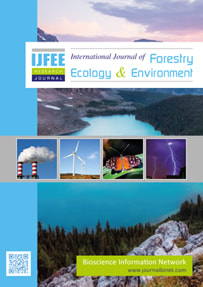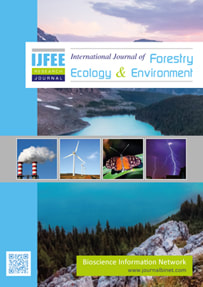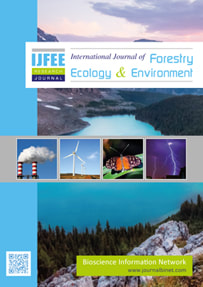International Journal of Forestry, Ecology & Environment
Volume 05 - Issue 01 | Year of Publication: 2021
Article Type: Research Article | No. 22, 2021 | Country: Nigeria | pp. 187-194 | Open Access
Title: Determination of mean annual increment and optimal rotation age for sustainable management of eucalyptus species in Afaka forest reserve, Nigeria
Authors: Saka, M. G
DOI: https://doi.org/10.18801/ijfee.050121.21
Title: Determination of mean annual increment and optimal rotation age for sustainable management of eucalyptus species in Afaka forest reserve, Nigeria
Authors: Saka, M. G
DOI: https://doi.org/10.18801/ijfee.050121.21
Determination of mean annual increment and optimal rotation age for sustainable management of eucalyptus species in Afaka forest reserve, Nigeria
Abstract
The study evaluates the mean annual increment (MAI) and optimal rotation age for the sustainable management of eucalyptus plantation in Afaka Forest reserve, Nigeria. To achieve the objectives of this study, the forest reserve was stratified into four age series. Fifty (50) sample plots (20 m X 20 m) were randomly laid across the four age series in the entire plantation. Variable of interest were measured in each of the compartments. The species volume per plot was estimated using Newton’s formula, and the yield (volume) with age of the species was generated using an exponential function, while the optimal rotation age was obtained when MAI was maximum. The annual allowable cut was determined using both area and volume control methods. The results show that E. camaldulensis has the highest mean volume (392.841 m3), while the least species volume of 281.217m3 was estimated for E. cloeziana. The maximum mean annual increment (MMAI) ranges between 7.321 to 19.323 (m3/ha/yr) across the four sampled compartments. The optimal rotation age ranges between 19 and 42 years, while the total number of trees available for cut ranges between 794 and 7,408 for E. cloeziana and E. camaldulensis species, respectively. This study has shown that mean annual increment and rotation age are of fundamental importance in forest business and shaping of stands future (harvest regulation) for sustainable management.
Key Words: Stratified, Evaluates, Plantation, Allowable cut, Age series and Compartment.
Abstract
The study evaluates the mean annual increment (MAI) and optimal rotation age for the sustainable management of eucalyptus plantation in Afaka Forest reserve, Nigeria. To achieve the objectives of this study, the forest reserve was stratified into four age series. Fifty (50) sample plots (20 m X 20 m) were randomly laid across the four age series in the entire plantation. Variable of interest were measured in each of the compartments. The species volume per plot was estimated using Newton’s formula, and the yield (volume) with age of the species was generated using an exponential function, while the optimal rotation age was obtained when MAI was maximum. The annual allowable cut was determined using both area and volume control methods. The results show that E. camaldulensis has the highest mean volume (392.841 m3), while the least species volume of 281.217m3 was estimated for E. cloeziana. The maximum mean annual increment (MMAI) ranges between 7.321 to 19.323 (m3/ha/yr) across the four sampled compartments. The optimal rotation age ranges between 19 and 42 years, while the total number of trees available for cut ranges between 794 and 7,408 for E. cloeziana and E. camaldulensis species, respectively. This study has shown that mean annual increment and rotation age are of fundamental importance in forest business and shaping of stands future (harvest regulation) for sustainable management.
Key Words: Stratified, Evaluates, Plantation, Allowable cut, Age series and Compartment.
HOW TO CITE THIS ARTICLE?
MLA
Saka, M. G. “Determination of mean annual increment and optimal rotation age for sustainable management of eucalyptus species in Afaka forest reserve, Nigeria”. International Journal of Forestry, Ecology and Environment, 05(01) (2021): 187-194.
APA
Saka, M. G. (2021). Determination of mean annual increment and optimal rotation age for sustainable management of eucalyptus species in Afaka forest reserve, Nigeria. International Journal of Forestry, Ecology and Environment, 05(01), 187-194.
Chicago
Saka, M. G. “Determination of mean annual increment and optimal rotation age for sustainable management of eucalyptus species in Afaka forest reserve, Nigeria”. International Journal of Forestry, Ecology and Environment, 05(01) (2021): 187-194.
Harvard
Saka, M. G. 2021. Determination of mean annual increment and optimal rotation age for sustainable management of eucalyptus species in Afaka forest reserve, Nigeria. International Journal of Forestry, Ecology and Environment, 05(01), pp. 187-194.
Vancouver
Saka, MG. Determination of mean annual increment and optimal rotation age for sustainable management of eucalyptus species in Afaka forest reserve, Nigeria. International Journal of Forestry, Ecology and Environment, 2021 July 05(01): 187-194.
MLA
Saka, M. G. “Determination of mean annual increment and optimal rotation age for sustainable management of eucalyptus species in Afaka forest reserve, Nigeria”. International Journal of Forestry, Ecology and Environment, 05(01) (2021): 187-194.
APA
Saka, M. G. (2021). Determination of mean annual increment and optimal rotation age for sustainable management of eucalyptus species in Afaka forest reserve, Nigeria. International Journal of Forestry, Ecology and Environment, 05(01), 187-194.
Chicago
Saka, M. G. “Determination of mean annual increment and optimal rotation age for sustainable management of eucalyptus species in Afaka forest reserve, Nigeria”. International Journal of Forestry, Ecology and Environment, 05(01) (2021): 187-194.
Harvard
Saka, M. G. 2021. Determination of mean annual increment and optimal rotation age for sustainable management of eucalyptus species in Afaka forest reserve, Nigeria. International Journal of Forestry, Ecology and Environment, 05(01), pp. 187-194.
Vancouver
Saka, MG. Determination of mean annual increment and optimal rotation age for sustainable management of eucalyptus species in Afaka forest reserve, Nigeria. International Journal of Forestry, Ecology and Environment, 2021 July 05(01): 187-194.
Article Type: Research Article | No. 22, 2021 | Country: Bangladesh | pp. 202-201 | Open Access
Title: Homestead agroforestry practices and livelihood status of farmers in Domar Upazila, Nilphamari, Bangladesh
Authors: Rana, M. S., Alam, M. M. and Sarker, M. A.
DOI: https://doi.org/10.18801/ijfee.050121.22
Title: Homestead agroforestry practices and livelihood status of farmers in Domar Upazila, Nilphamari, Bangladesh
Authors: Rana, M. S., Alam, M. M. and Sarker, M. A.
DOI: https://doi.org/10.18801/ijfee.050121.22
Homestead agroforestry practices and livelihood status of farmers in Domar Upazila, Nilphamari, Bangladesh
Abstract
The study was conducted for three months from October to December, 2020 at Domar Upazila of Nilphamari District, Bangladesh, to observe the socio-economic characteristics of the farmers in the study area and explore the relationships among the selected farmers and plant species diversity. Data were collected by face-to-face interviews to know the independent and dependent variables. The independent variables were age, education, family member, total land size, homestead size, cultivable land size, fallow land size, annual income, knowledge about trees and knowledge of agroforestry, while the dependent variables of the study were plant diversity and existing agroforestry practices. The average age of farmers was about 45 years and it ranged from 19 to 70 years. A few people have education in this area and their education level ranged from 0-14 with an average of almost 05. The family size of the respondents ranged from 02-22, with an average of about 06. The farmer’s farm sizes were from 03 to 990 decimals. The average homestead size was almost 18 decimals regarding ranged from 01-115 decimals. The rank of fallow land size was from 01-50 decimals, including average number of about 01 decimal. The farmer’s annual income was from 24000 to 400000 Tk. while considering average no. 110430 Tk. Total 22 plant species were demonstrated in the study area, of which 03 timbers, 15 fruits, 03 medicinal, 01 non-timber were counted. Farmers recently, i.e. cultivate crops/vegetables in association with different tree species. The result concludes that there is a great scope for improving farmer’s livelihood enormously by practising the agroforestry system. Agroforestry practices with proper tree-crop combinations also increase species diversity and ensure economic return.
Key Words: Diversity, Area, Species, Practice and Systems
Abstract
The study was conducted for three months from October to December, 2020 at Domar Upazila of Nilphamari District, Bangladesh, to observe the socio-economic characteristics of the farmers in the study area and explore the relationships among the selected farmers and plant species diversity. Data were collected by face-to-face interviews to know the independent and dependent variables. The independent variables were age, education, family member, total land size, homestead size, cultivable land size, fallow land size, annual income, knowledge about trees and knowledge of agroforestry, while the dependent variables of the study were plant diversity and existing agroforestry practices. The average age of farmers was about 45 years and it ranged from 19 to 70 years. A few people have education in this area and their education level ranged from 0-14 with an average of almost 05. The family size of the respondents ranged from 02-22, with an average of about 06. The farmer’s farm sizes were from 03 to 990 decimals. The average homestead size was almost 18 decimals regarding ranged from 01-115 decimals. The rank of fallow land size was from 01-50 decimals, including average number of about 01 decimal. The farmer’s annual income was from 24000 to 400000 Tk. while considering average no. 110430 Tk. Total 22 plant species were demonstrated in the study area, of which 03 timbers, 15 fruits, 03 medicinal, 01 non-timber were counted. Farmers recently, i.e. cultivate crops/vegetables in association with different tree species. The result concludes that there is a great scope for improving farmer’s livelihood enormously by practising the agroforestry system. Agroforestry practices with proper tree-crop combinations also increase species diversity and ensure economic return.
Key Words: Diversity, Area, Species, Practice and Systems
HOW TO CITE THIS ARTICLE?
MLA
Rana, M. S. et al, “Homestead agroforestry practices and livelihood status of farmers in Domar Upazila, Nilphamari, Bangladesh”. International Journal of Forestry, Ecology and Environment, 05(01) (2021): 195-201.
APA
Rana, M. S., Alam, M. M. and Sarker, M. A. (2021). Homestead agroforestry practices and livelihood status of farmers in Domar Upazila, Nilphamari, Bangladesh. International Journal of Forestry, Ecology and Environment, 05(01), 195-201.
Chicago
Rana, M. S., Alam, M. M. and Sarker, M. A. “Homestead agroforestry practices and livelihood status of farmers in Domar Upazila, Nilphamari, Bangladesh”. International Journal of Forestry, Ecology and Environment, 05(01) (2021): 195-201.
Harvard
Rana, M. S., Alam, M. M. and Sarker, M. A. 2021. Homestead agroforestry practices and livelihood status of farmers in Domar Upazila, Nilphamari, Bangladesh. International Journal of Forestry, Ecology and Environment, 05(01), pp. 195-201.
Vancouver
Rana, MS, Alam, MM and Sarker, MA. Homestead agroforestry practices and livelihood status of farmers in Domar Upazila, Nilphamari, Bangladesh. International Journal of Forestry, Ecology and Environment, 2021 September 05(01): 195-201.
MLA
Rana, M. S. et al, “Homestead agroforestry practices and livelihood status of farmers in Domar Upazila, Nilphamari, Bangladesh”. International Journal of Forestry, Ecology and Environment, 05(01) (2021): 195-201.
APA
Rana, M. S., Alam, M. M. and Sarker, M. A. (2021). Homestead agroforestry practices and livelihood status of farmers in Domar Upazila, Nilphamari, Bangladesh. International Journal of Forestry, Ecology and Environment, 05(01), 195-201.
Chicago
Rana, M. S., Alam, M. M. and Sarker, M. A. “Homestead agroforestry practices and livelihood status of farmers in Domar Upazila, Nilphamari, Bangladesh”. International Journal of Forestry, Ecology and Environment, 05(01) (2021): 195-201.
Harvard
Rana, M. S., Alam, M. M. and Sarker, M. A. 2021. Homestead agroforestry practices and livelihood status of farmers in Domar Upazila, Nilphamari, Bangladesh. International Journal of Forestry, Ecology and Environment, 05(01), pp. 195-201.
Vancouver
Rana, MS, Alam, MM and Sarker, MA. Homestead agroforestry practices and livelihood status of farmers in Domar Upazila, Nilphamari, Bangladesh. International Journal of Forestry, Ecology and Environment, 2021 September 05(01): 195-201.
Article Type: Research Article | No. 23, 2021 | Country: Bangladesh | pp. 201-214 | Open Access
Title: Soil properties under eight different land uses in Bandarban hill district of Bangladesh
Authors: Mamun, M. M. A. A., Emon, S. B. T. A. and Alam, M. S.
DOI: https://doi.org/10.18801/ijfee.050121.23
Title: Soil properties under eight different land uses in Bandarban hill district of Bangladesh
Authors: Mamun, M. M. A. A., Emon, S. B. T. A. and Alam, M. S.
DOI: https://doi.org/10.18801/ijfee.050121.23
Soil properties under eight different land uses in Bandarban hill district of Bangladesh
Abstract
The Hill Tracts of Bangladesh has been exploited beyond its sustainable limits in the last century. Research for restoration and sustainable practices are now emphasized in this region. Studies on present soil conditions are essential as these will determine the type and intensity of inputs needed to restore and achieve sustainability. This study was conducted to assess the physical and chemical properties of soil in the Bandarban hill district under eight different land uses. Convenience sampling was done in the Ruma upazila of the district, and eight different land uses were selected as- 1. Jhum (shifting cultivation) land, 2. Turmeric cultivated area, 3. Papaya orchard, 4. Tectona grandis (Teak) plantation, 5. Banana orchard, 6. Orange orchard, 7. Natural forest and 8. Fallow land- for the collection of soil. Most of the nutrient values (Nitrogen, Phosphorus, Potassium, Calcium, Magnesium, Sulfur, organic carbon) and physical soil factors (maximum water holding capacity, bulk density, porosity) were significantly (p ≤ 0.05) better in some land uses, as shown in the hierarchy of natural forest > fallow land >Banana orchard >Papaya orchard. A monoculture of Tectona grandis plantation was found significantly (p ≤ 0.05) poor in topsoil conditions. In all cases, mostly used soil showed less tendency toward sustainable production although higher nutrient availability can be found in those soils (such as application of inorganic fertilizer) but the presence of the lower amount of organic deposits implies that there is a lack of natural source of nutrients in the long run. This research can benefit both policymakers and practitioners to implement sustainable land use practices in Bandarban and the Hill Tracts of Bangladesh.
Key Words: Chittagong Hill Tracts, Land use, Soil physical properties, Soil chemical properties, Nitrogen and Organic carbon.
Abstract
The Hill Tracts of Bangladesh has been exploited beyond its sustainable limits in the last century. Research for restoration and sustainable practices are now emphasized in this region. Studies on present soil conditions are essential as these will determine the type and intensity of inputs needed to restore and achieve sustainability. This study was conducted to assess the physical and chemical properties of soil in the Bandarban hill district under eight different land uses. Convenience sampling was done in the Ruma upazila of the district, and eight different land uses were selected as- 1. Jhum (shifting cultivation) land, 2. Turmeric cultivated area, 3. Papaya orchard, 4. Tectona grandis (Teak) plantation, 5. Banana orchard, 6. Orange orchard, 7. Natural forest and 8. Fallow land- for the collection of soil. Most of the nutrient values (Nitrogen, Phosphorus, Potassium, Calcium, Magnesium, Sulfur, organic carbon) and physical soil factors (maximum water holding capacity, bulk density, porosity) were significantly (p ≤ 0.05) better in some land uses, as shown in the hierarchy of natural forest > fallow land >Banana orchard >Papaya orchard. A monoculture of Tectona grandis plantation was found significantly (p ≤ 0.05) poor in topsoil conditions. In all cases, mostly used soil showed less tendency toward sustainable production although higher nutrient availability can be found in those soils (such as application of inorganic fertilizer) but the presence of the lower amount of organic deposits implies that there is a lack of natural source of nutrients in the long run. This research can benefit both policymakers and practitioners to implement sustainable land use practices in Bandarban and the Hill Tracts of Bangladesh.
Key Words: Chittagong Hill Tracts, Land use, Soil physical properties, Soil chemical properties, Nitrogen and Organic carbon.
HOW TO CITE THIS ARTICLE?
MLA
Mamun, M. M. A. A. et al., “Soil properties under eight different land uses in Bandarban hill district of Bangladesh”. International Journal of Forestry, Ecology and Environment, 05(01) (2021): 202-214.
APA
Mamun, M. M. A. A., Emon, S. B. T. A. and Alam, M. S. (2021). Soil properties under eight different land uses in Bandarban hill district of Bangladesh. International Journal of Forestry, Ecology and Environment, 05(01), 202-214.
Chicago
Mamun, M. M. A. A., Emon, S. B. T. A. and Alam, M. S. “Soil properties under eight different land uses in Bandarban hill district of Bangladesh”. International Journal of Forestry, Ecology and Environment, 05(01) (2021): 202-214.
Harvard
Mamun, M. M. A. A., Emon, S. B. T. A. and Alam, M. S. 2021. Soil properties under eight different land uses in Bandarban hill district of Bangladesh. International Journal of Forestry, Ecology and Environment, 05(01), pp. 202-214.
Vancouver
Mamun, MMAA, Emon, SBTA and Alam, MS. Soil properties under eight different land uses in Bandarban hill district of Bangladesh. International Journal of Forestry, Ecology and Environment, 2021 September 05(01): 202-214.
MLA
Mamun, M. M. A. A. et al., “Soil properties under eight different land uses in Bandarban hill district of Bangladesh”. International Journal of Forestry, Ecology and Environment, 05(01) (2021): 202-214.
APA
Mamun, M. M. A. A., Emon, S. B. T. A. and Alam, M. S. (2021). Soil properties under eight different land uses in Bandarban hill district of Bangladesh. International Journal of Forestry, Ecology and Environment, 05(01), 202-214.
Chicago
Mamun, M. M. A. A., Emon, S. B. T. A. and Alam, M. S. “Soil properties under eight different land uses in Bandarban hill district of Bangladesh”. International Journal of Forestry, Ecology and Environment, 05(01) (2021): 202-214.
Harvard
Mamun, M. M. A. A., Emon, S. B. T. A. and Alam, M. S. 2021. Soil properties under eight different land uses in Bandarban hill district of Bangladesh. International Journal of Forestry, Ecology and Environment, 05(01), pp. 202-214.
Vancouver
Mamun, MMAA, Emon, SBTA and Alam, MS. Soil properties under eight different land uses in Bandarban hill district of Bangladesh. International Journal of Forestry, Ecology and Environment, 2021 September 05(01): 202-214.



